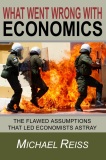("customers" = individuals, businesses, foreign governments etc. MS = money supply. MB = monetary base)
Don't forget that MB is much smaller than MS.
Factors that can lead to increases:
- Customers taking out new loans from banks. (Directly increases MS)
- Governments printing money to buy their own bonds to "pay" for their debt. (Directly increases MB)
- Governments printing money expressly for the purposes of avoiding deflation. (Directly increases MB)
- Lowering reserve requirements (gives permission to increase MS via extra allowed loans, but that's if the banks can find suitable borrowers)
- Lowering capital requirements (gives permission to increase MS via extra allowed loans, but that's if the banks can find suitable borrowers)
- Customers paying back loans to banks (Directly decreases MS)
- Customers defaulting on bank loans (Directly decreases MS)
- Raising reserve requirements (leads to decreased MS)
- Raising capital requirements (leads to decreased MS)




No comments:
Post a Comment